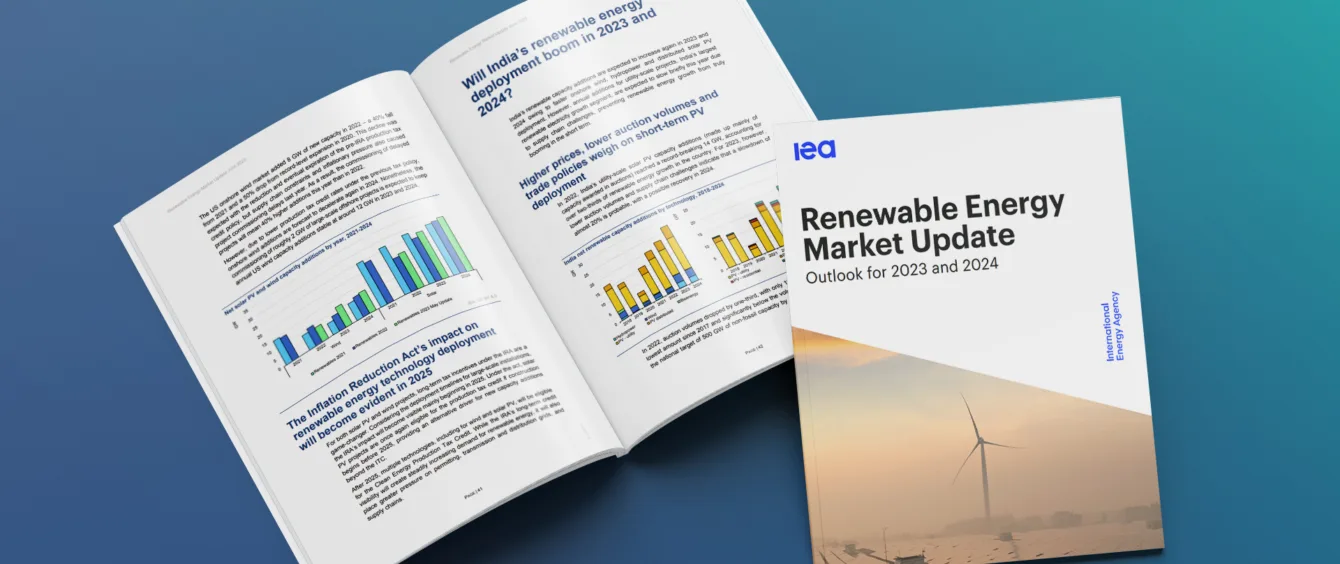Hot on the heels of its World Energy Investment report, which forecast a $1.7 trillion spend on clean energy in 2023, the International Energy Agency (IEA) has released its Renewable Energy Market Update.
The new report shows solar power surging ahead. Renewable energy additions overall rose by 13% in 2022 to nearly 340 GW, a record, with solar accounting for a huge 220 GW. 85% of the new solar capacity was deployed in Europe and China.
Hydropower was the second largest contributor, owing to the completion of multiple large projects, mainly in Asia, while wind came in third, with the level of new capacity additions falling 21% year on year.
Strong forecasts for 2023
According to the IEA’s projections, 2023 and 2024 will also be record years, again with solar power being the primary expansionary force. New renewable capacity additions in 2023 are expected to exceed 440 GW, with solar accounting for 65% of the total.
Despite costs edging up, wind and solar power remain the most competitive options, the IEA says. Growth is being supported by security of supply concerns and expanding policy support. These factors are more than outweighing the impact of supply chain constraints and higher interest rates overall, although wind power faces some specific challenges.
Of particular note is that almost half of the increase in solar power is expected to come from small residential and commercial systems. In addition, following two years of decline, onshore wind is expected to rebound by 70% in 2023, contributing 107 GW of new capacity, an all-time record.
Wind power challenges
While solar power is surging ahead across multiple markets, the outlook for wind is more mixed, despite the expectation of strong onshore wind capacity growth this year.
The bounce back in 2023 is expected to come mainly from onshore projects in China delayed by Covid-19 restrictions, which have now been lifted. Supply chains issues also slowed project completions in Europe and the US, pushing them back into 2023.
Offshore wind deployment, meanwhile, suffered from a low volume of projects under construction outside China in 2022. It is expected to increase by almost 50% in 2023 from last year’s levels, but to remain below record levels worldwide.
In 2024, outside China, new wind additions are expected to decline. Various factors, such as undersubscribed auctions, permitting delays and turbine placement restrictions are holding back growth in Europe. In the US, reduced production tax credits are expected to see new capacity additions decelerate, the IEA says.
The challenges facing wind deployment are also evident in the supply chain.
The agency estimates that global manufacturing capacity for solar PV will reach nearly 1,000 GW in 2024. This is on track to meet the annual demand required for a net zero carbon world by 2050. In contrast, wind equipment manufacturing is expanding more slowly and may struggle to keep up with demand growth through 2030, the report says.
Ukraine crisis accelerates European renewable energy deployment
In Europe, new renewable power capacity is proving a key tool both for reducing greenhouse gas emissions and bolstering security of energy supply.
Policy changes emanating from the war in Ukraine have prompted the IEA to revise upward by 40% its forecasts for renewable energy additions in the region in 2023 and 2024. Almost three-quarters of this revision reflects the growing popularity of small-scale solar installations, which have become increasingly competitive as gas scarcity raised wholesale electricity prices.
Europe has also taken major steps to address one of the energy transition’s greatest constraints – slow permitting. The IEA says European governments in the last 18 months introduced more policy and regulatory changes to accelerate permitting than in the previous decade. However, the impact of these changes is still to come, and will most likely be felt after the report’s forecast period.
Mixed picture at auctions
Policy uncertainties and volatile prices left one-sixth of renewable energy auction volumes unallocated in 2022 globally, although a record-breaking 100 GW of capacity was awarded. Europe accounted for two-thirds of the unallocated auction volumes, reflecting the limiting factors still prevalent with regard to a faster energy transition.
Nonetheless, according to the IEA, EU electricity consumers will save some €100 billion in the period 2021-2023 as a result of the competitive cost of new solar and wind capacity. The growth of these low-cost energy sources will displace an estimated 230 TWh of electricity generated from fossil fuels, the report says, reducing both emissions and consumer bills.
